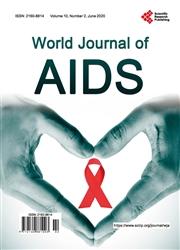Strategies for Good Retention Rates in HIV Exposed Sero-Negatives (HESN) Individuals: Important Consideration for HIV Biomedical Prevention Trials in Nigeria
引用次数: 0
Abstract
Background: Retention in clinical trials is critical for the accumulation of data over time and retaining enough power for comprehensive analysis. We document for the first time the retention rates and factors associated with retention among a cohort of HIV exposed seronegative (HESN) person in a discordant relationship. Understanding these factors will provide valuable cues for maintaining high retention rates in future HIV biomedical prevention studies in this cohort. Aim: We aimed to document retention rates and associated factors relevant in conducting future HIV prevention studies using a cohort of HIV exposed sero-negative individuals. Method: We conducted a prospective cohort study to enroll HESN persons in discordant relationship based on established inclusion criteria that includes: Established sero-discordance with at least 3 months in the relationship; above 18 years and willingness to be followed up. Relevant ethical approvals were obtained. Following informed consent at enrollment, standardized questionnaires on risk behavior and factors that may affect retention were administered at enrollment and during the 2 years follow-up. This was spread over 10 follow-up visits to mimic phase a 2b HIV vaccine clinical trial follow up and duration. In addition, clinical examinations were done and samples collected for safety lab during the follow up visits. Estimation of CD4 and viral load was also done for the HIV+ partners of HESN study participants. Results: Six hundred and sixty HESN persons were screened and 534 (81%) enrolled (i.e. month 0) and followed up. There was a decline in retention from 96% at month 1 (visit 1) to 78% at month 24 (Visit 10). Sharpest drop out from the study occurred at month 1 (20%) and month 15 (14%) follow-up visits. Inability to reach study participants, unwillingness of study participants to continue study, and mortality of the HIV+ partners of HESN participants were the commonest reasons for participant study termination. Furthermore, no or low level of formal education, (AOR 2.79; 95% CI 1.29 - 6.02, p = 0.06), being unemployed (AOR 1.96; 95% CI 1.18 - 3.29, p < 0.01) and inconsistent use of condoms (AOR 1.83; 95% CI 1.16 - 2.91, p < 0.01) were predictors of non-completion of the study. Conclusion: Retention rates decline especially during month 1 (visit 1) and month 15 (visit 7) mainly due to participants’ inability to locate study participants and death of HIV+ partners of HESN enrollees. One unexpected finding from our study is that those who were more consistent in their use of condom were more likely to stay in the study. This is a possible indication of commitment or an incentive for giving free condoms at study visits. This is encouraging for combined biomedical prevention strategies where consistent condoms use is desired. On the other hand, factors such as unemployment, poor formal education and never/occasional condom use were predictors of study drop out. Retention strategies should consider these barriers and predictors of drop out as exclusion criteria in preparation for future HIV biomedical prevention trial.艾滋病毒暴露血清阴性(HESN)个体良好保留率的策略:尼日利亚艾滋病毒生物医学预防试验的重要考虑因素
背景:临床试验中的保留对于随着时间的推移积累数据和保留足够的综合分析能力至关重要。我们首次记录了一组不一致关系的HIV暴露血清阴性(HESN)人群的保留率和与保留相关的因素。了解这些因素将为在该队列的未来HIV生物医学预防研究中保持高保留率提供有价值的线索。目的:我们旨在记录保留率和相关因素,以进行未来的艾滋病毒预防研究,使用一组暴露于艾滋病毒的血清阴性个体。方法:我们进行了一项前瞻性队列研究,根据既定的纳入标准招募关系不一致的HESN患者,其中包括:关系至少3个月的血清不一致;18岁以上,愿意接受随访。获得了相关的伦理批准。在入组时获得知情同意后,在入组和2年随访期间,对风险行为和可能影响保留的因素进行了标准化问卷调查。这项研究进行了10次随访,以模拟2b期HIV疫苗临床试验的随访和持续时间。此外,在随访期间,还进行了临床检查,并为安全实验室收集了样本。还对HESN研究参与者的HIV+伴侣进行了CD4和病毒载量的估计。结果:筛选了660名HESN患者,534人(81%)入选(即0个月)并进行了随访。保留率从第1个月(访视1)的96%下降到第24个月(第10次访视)的78%。研究中最严重的脱落发生在第1个月(20%)和第15个月(14%)的随访中。无法联系到研究参与者、研究参与者不愿继续研究以及HESN参与者的HIV+伴侣死亡是参与者研究终止的最常见原因。此外,没有或低水平的正规教育(AOR 2.79;95%CI 1.29-6.02,p=0.06)、失业(AOR 1.96;95%CI 1.18-3.29,p<0.01)和不一致使用避孕套(AOR 1.83;95%CI 1.16-2.91,p<0.01)是未完成研究的预测因素。结论:保留率下降,尤其是在第1个月(访视1)和第15个月(第7次访视),主要是由于参与者无法找到研究参与者以及HESN参与者的HIV+伴侣死亡。我们研究中的一个意外发现是,那些使用避孕套更一致的人更有可能留在研究中。这可能是承诺或激励在研究访问中免费提供避孕套的一个迹象。这对于需要持续使用避孕套的生物医学联合预防策略来说是令人鼓舞的。另一方面,失业、正规教育程度低和从不/偶尔使用避孕套等因素是研究辍学的预测因素。保留策略应将这些障碍和辍学预测因素作为排除标准,为未来的HIV生物医学预防试验做准备。
本文章由计算机程序翻译,如有差异,请以英文原文为准。
求助全文
约1分钟内获得全文
求助全文

 求助内容:
求助内容: 应助结果提醒方式:
应助结果提醒方式:


